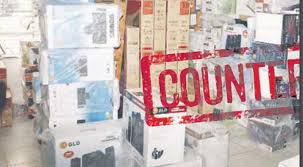The production of substandard and fake drugs is an infinite and underreported problem, particularly affecting poorer countries including, Somaliland. It is an important cause of morbidity, mortality, and loss of public confidence in medicines and health structures. The prevalence of counterfeit drugs appears to be and has not been opposed by close cooperation between drug importers, governments, or international organizations concerned with trade, health, customs and excise, and counterfeiting.
The scale of the problem:
It has been estimated that up to 25% of all sold drugs are fake, and in parts of Africa and Asia this figure exceeds 50%. A particularly serious case involved counterfeit versions of bevacizumab (Avastin), a cancer-fighting medication. Avastin’s manufacturer, Roche, notified physicians in February 2012 of a counterfeit version of bevacizumab that contained salt and starch, but not the active component of the drug.1 Another example of the dangers of counterfeit medications in the United States is the counterfeit case of the blood thinner heparin. In this case, the active ingredient was replaced with a cheaper substance that caused patients to have adverse reactions and resulted in a nationwide recall of heparin.2 The medication, whose counterfeit active ingredient came from China (a major source of counterfeiting), was suspected to be the cause of as many as 81 deaths.2 The implications for patients are clear: counterfeits can kill.
Preventing counterfeit medicines from entering Somaliland is difficult, because nearly all drugs are made in overseas and are imported to Somaliland directly by local importers, and surprisingly, the drugs does not go through proper screening and checking of its quality.
Consumer issues: Harmful effects
Patients can experience a variety of problems from the use of counterfeit drugs. The various scenarios depend on the ingredients that make up the counterfeit drug. The first scenario is a counterfeit drug that contains no active ingredient or no harmful ingredients.3 In the case of the counterfeit drug that has no active ingredient, the drug fails to help the patient get better, which can ultimately harm the patient. In the case of antibiotics, for example, this can promote antibiotic resistance and the use of stronger antibiotics, because physicians would believe that the first-line drug was not working, not knowing that the patient had been taking a counterfeit drug.3
A second scenario is that the counterfeit drug has no active ingredient and may have any number of harmful ingredients, including bacteria-laced water, toxic yellow paint, floor wax, colored dye, powdered cement, boric acid, and antifreeze.3 More than 500 children around the world died from counterfeit cough syrup that was tainted with ethylene glycol (ie, antifreeze).3 In another case, counterfeit inhalers for the treatment of pediatric cystic fibrosis were found to contain contaminated bacteria that went directly into the lungs of unsuspecting children.4 Another case involved patients with cancer who used erythropoietin, in which the counterfeit intravenous drug was diluted with bacterially contaminated water and injected directly into the patients.4
Another case involving a counterfeit drug that contains the wrong concentration or wrong dose of the drug. One example of this is the case of a physician who was supplied with a research version of onabotulinumtoxinA (Botox) that was much more concentrated than the real medicine, and is not intended for human use.5 This resulted in respiratory paralysis and near death for several patients, including the physician who was using it himself.5 In general, counterfeit drugs create uncertainty, confusion, and doubts about the value of the real drug and may lead to the use of alternative, less-desirable drugs or therapies.
Suggestions on How to Reduce Drug Counterfeiting
- Increase public awareness.
- Improve management of supply chain
- Apply fines and jail sentences for convicted sellers of counterfeit drugs
- Apply penalty to physicians who knowingly provide or prescribe counterfeit drugs to their patients
- Improve cooperation with foreign governments regarding this issue
- Improve quality control
- Establish use of technology to tract and trace counterfeiting drugs
- Sell drug supplies only to licensed manufacturers
Conclusion
Solving the counterfeit drugs problem is important to ensure that patients do not lose faith in the benefits of pharmaceuticals and become nonadherent with their treatments. The expansion of the Internet, and the difficulty in controlling drug suppliers from the Internet, have greatly increased consumer purchases of counterfeit drugs. Controlling the availability of counterfeit drugs is not easy, but it is necessary, given the tremendous public health issues concerning counterfeit drugs, which can harm or kill people.
By: Mustafe Khalid Mohamed
B.Pharm (IIUC), M.Sc. in Pharmacology & Clinical Pharmacy (NSU)
Email: fawzi3827@gmail.com
References:
- Palmer E. Feds nail key player in counterfeit Avastin probe: contract employer says he was aware Canada Drugs was breaking the law. FiercePharma. April 24, 2013. fiercepharma.com/story/feds-nail-key-player-counterfeit-avastin-probe/201304-24 Accessed April 26, 2013.
- Toscano P. The dangerous world of counterfeit prescription drugs. CNBC; October 4, 2011.cnbc.com/id/44759526Accessed May 23, 2014. [Google Scholar]
- Liang BA. Fade to black: importation and counterfeit drugs. Am J Law Med. 2006; 32: 279–323
- US Food and Drug Administration. FDA warns consumers about counterfeit Alli: the counterfeit products contain controlled substance sibutramine. Press release. January 18, 2010.fda.gov/NewsEvents/Newsroom/PressAnnouncements/ucm197857Accessed May 3, 2014.
- Liang BA. Fade to black: importation and counterfeit drugs. Am J Law Med. 2006; 32: 279–323






































